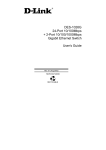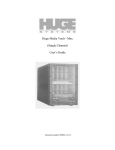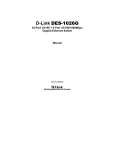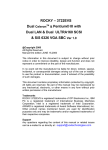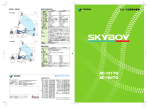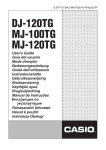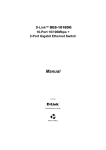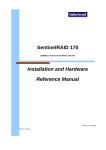Download D-Link DES-1026G Specifications
Transcript
D-Link DES-1026G 24-Port 10/100Mbps + 2-Port 10/100/1000Mbps Gigabit Ethernet Switch Manual Version 3.00 January 2, 2008 PN: 29071600E7224T0 Table of Contents 1. Package Contents ............................................. 3 2. Introduction........................................................ 3 3. Installation.......................................................... 8 4. Technical Specifications..................................11 2 1. Package Contents One DES-1026G 24-Port 10/100Mbps + 2-Port 10/100/1000Mbps Gigabit Ethernet Switch One AC power cord Four rubber feet to be used for shock cushioning Screws and two mounting brackets Manual If any of the above items are missing, please contact your reseller. 2. Introduction Congratulations on your purchase of the DES-1026G 24-Port 10/100Mbps + 2-Port 10/100/1000Mbps Gigabit Ethernet Switch. This device integrates 1000Mbps Gigabit Ethernet, 100Mbps Fast Ethernet, and 10Mbps Ethernet network capabilities into one cost-effective solution. This manual discusses how to install your DES-1026G 24-Port 10/100Mbps + 2-Port 10/100/1000Mbps Gigabit Ethernet Switch. In this manual, the term “Switch” (first letter upper case) refers to your DES-1026G 24-Port 10/100Mbps + 2-Port 10/100/1000Mbps Gigabit Ethernet Switch, and “switch” (first letter lower case) refers to other Ethernet switches. This chapter describes the features of the Switch and some background information about Ethernet/ Fast Ethernet/ Gigabit Ethernet switching technology. Fast Ethernet Technology Ethernet, along with its speedier counterpart Fast Ethernet, is the most popular networking standard in use today. 100BaseT Fast Ethernet is an 3 extension of the 10BaseT Ethernet standard, designed to raise the data transmission capacity of 10BaseT from 10Mbits/sec to 100Mbits/sec. An important technology incorporated by 100BaseT is its use of the Carrier Sense Multiple Access with Collision Detection (CSMA/CD) protocol which is the same protocol that 10BaseT uses - because of its ability to work with several different types of cable, including basic twisted-pair wiring. Both of these features play an important role in network considerations, and they make 100BaseT an attractive migration path for those networks based on 10BaseT. Since the 100Mbps Fast Ethernet is compatible with all other 10Mbps Ethernet environments, it provides a straightforward upgrade and takes advantage of the existing investment in hardware, software, and personnel training. Switching Technology Switching is a cost-effective way of increasing the total network capacity available to users on a LAN. If an Ethernet network begins to display symptoms of congestion, low throughput, slow response times, and high rates of collision, installing a switch to an network can preserve much or all of the existing network's cabling and workstation interface card infrastructure while still greatly enhancing the throughput for users. A switch is a viable solution even if demanding applications, such as multimedia production and video conferencing, are on the horizon. The most promising techniques, as well as the best return on investment, could well consist of installing the right mixture of Ethernet switches. A switch increases capacity and decreases network loading by dividing a local area network into different LAN segments. Dividing a LAN into multiple segments is one of the most common ways of increasing available bandwidth. If segmented correctly, most network traffic will remain within a single segment, enjoying the full-line speed bandwidth of that segment. Switches provide full-line speed and dedicated bandwidth for all connections. This is in contrast to the hubs, which use the traditional shared networking topology, where the connected nodes contend for the same network bandwidth. When two switching nodes are communicating, they are connected with a dedicated channel between them, so there is no contention for network bandwidth with other nodes. As a result, the switch reduces considerably the likelihood of traffic congestion. 4 For Fast Ethernet networks, a switch is an effective way of eliminating the problem of chaining hubs beyond the “two-repeater limit.” A switch can be used to split parts of the network into different collision domains, making it possible to expand your Fast Ethernet network beyond the 205-meter network diameter limit for 100BASE-TX networks. Switches supporting both traditional 10Mbps Ethernet and 100Mbps Fast Ethernet are also ideal for bridging between existing 10Mbps networks and new 100Mbps networks. Switching LAN technology is a marked improvement over the previous generation of network hubs and bridges, which were characterized by higher latencies. Routers have also been used to segment local area networks, but the cost of a router, the setup and maintenance required make routers relatively impractical. Today switches are an ideal solution to most kinds of local area network congestion problems. Features and Benefits (24) 10/100BASE-TX Fast Ethernet ports + (2) 1000BASE-T Gigabit Ethernet ports Auto MDI/MDI-X support on each port Full/half duplex transfer mode for 10/100Mbps Fast Ethernet transmission Full duplex transfer mode for Gigabit Ethernet transmission Wire-speed reception and transmission Store-and-Forward switching method Integrated address Look-Up Engine, supports 8K MAC addresses Supports 320KBytes RAM for data buffering Extensive front-panel diagnostic LEDs IEEE 802.3x flow control for full-duplex Back pressure flow control for half-duplex Standard 19” Rack-mount size 5 LEDs LED stands for Light-Emitting Diode. The front panel LEDs provides instant status feedback and simplifies monitoring and troubleshooting tasks. LED indicators of the Switch POWER On When the Power LED light is on, the Switch is receiving power. Off When the Power LED light is off , the power cord is improperly connected. Ports 1-24 Status LEDs LINK/ACT On When the LED light is on, the respective port is connected to the 10/100Mbps Ethernet network. Blinking When the LED light is blinking, the port is transmitting or receiving data on the 10/100Mbps Ethernet network. Off No link. 100Mbps On When the LED light is on, the respective port is connected to a 100Mbps Ethernet network. Off When the LED light is off, the respective port is connected to a 10Mbps Ethernet network, or no link. Ports 25 & 26 Status LEDs LINK/ACT On When the LED lights on, the respective port is connected to a 10/100/1000Mbps Ethernet network. 6 Blinking When the LED is blinking, the respective port is transferring or receiving data on a 10/100/1000Mbps Ethernet network. Off No link. 1000Mbps On When the LED lights on, the respective port is connected to a Gigabit Ethernet network. Off The respective port is connected to a 10/100Mbps Ethernet network, or no link. 100Mbps On When the LED lights on, the respective port is connected to a 100Mbps Fast Ethernet network. Off When the LED light is off, the respective port is connected to a 10Mbps or Gigabit Ethernet network or there is no link. Connections Front Panel 10/100 Base-TX Twisted-Pair Ports └──────┘ └───┘ LED Indicators 1000 Base-T Twisted-Pair Ports 10/100BASE-TX Twisted-Pair Ports (Port1~24) These ports support network speeds of either 10Mbps or 100Mbps, and can operate in half- and full- duplex transfer modes. These ports also support automatic MDI/MDI-X crossover detection, giving true “plug and play” capability. Just plug the network cable directly into the hub; you can use either straight-through or crossover cable. 7 1000BASE-T Twisted Pair Ports (Port 25~26) The DES-1026G is equipped with two Gigabit twisted pair ports that are auto negotiable 10/100/1000Mbps and also support auto MDI/MDIX crossover detection. These two ports can operate in half- and full- duplex modes. Rear Panel AC Power Connector This is a three-pronged connector that supports the power cord. Plug in the female connector of the provided power cord into this connector, and the male into a power outlet. Supported input voltages range from 100~240V AC at 50~60Hz. 3. Installation The site where you place the DES-1026G may greatly affect its performance. When installing, take the following into your consideration: Install the DES-1026G in a fairly cool and dry place. See Technical Specifications for the acceptable temperature and humidity operating ranges. Install the DES-1026G in a site free from strong electromagnetic field generators (such as motors), vibration, dust, and direct exposure to sunlight. Leave at least 10cm (about 4 inches) of space at the front and rear of the hub for ventilation. Install the DES-1026G on a sturdy, level surface that can support its weight, or in an EIA standard-size equipment rack. 8 When installing the Switch on a level surface, attach the rubber feet to the bottom of each device. The rubber feet cushion the hub and protects the hub case from scratching. Attach the adhesive rubber pads to the bottom Rack Mounting The DES-1026G can be mounted in an EIA standard-size, 19-inch rack, which can be placed in a wiring closet with other equipments. Attach the mounting brackets to both sides of the Switch (one at each side), and secure them with the provided screws. Use the screws provided. Then, use screws provided with the equipment rack to mount the Switch in the rack. Mount the Switch in the rack 9 Connecting Network Cable The DES-1026G supports 10/100/1000Mbps Gigabit Ethernet. It runs full/half duplex transfer mode for 10/100Mbps and full duplex transfer mode for 1000Mbps. Each port on the DES-1026G supports AutoMDI/MDI-X. Auto-MDI/MDI-X is a feature that eliminates the need for worrying about using either a standard or crossover cable—you can use either one—and allows any port to be an uplink port. AC Power The DES-1026G can be used with AC power supply 100~240V AC, 50~60 Hz. The power switch is located at the rear of the unit adjacent to the AC power connector. The switch’s power supply will adjust to the local power source automatically and may be turned on without having any or all LAN segment cables connected. 10 4. Technical Specifications General Standards Protocol Data Transfer Rate Topology Network Cables Number of Ports IEEE 802.3 10BASE-T Ethernet IEEE 802.3u 100 BASE-TX Fast Ethernet IEEE 802.3ab 1000BASE-T Gigabit Ethernet CSMA/CD Ethernet: 10Mbps (half duplex), 20Mbps (full duplex) Fast Ethernet: 100Mbps (half duplex), 200Mbps (full duplex) Gigabit Ethernet: 2000Mbps (full duplex) Star 10BASET: 2-pair UTP/STP Cat. 3,4,5; up to 100m 100BASE-TX: 2-pair UTP/STP Cat. 5; up to 100m 1000BASE-T: 4-pair UTP/STP Cat. 5; up to 100m (Cat. 5E is recommended) 24 ×10/100BASE-TX Auto-MDIX STP ports 2 × 1000BASE-T Auto-MDIX STP ports Physical and Environmental AC inputs 100 to 240V AC, 50/60 Hz internal universal power supply Power 9.8 watts. (max.) Consumption Temperature Operating: 0°~40°C, Storage: -10°~70°C Humidity Dimensions Emissions Safety Performance Transmits Method RAM Buffer Filtering Address + Table Packet Filtering/ Forwarding Rate MAC Address Learning Operating: 10%~90%, Storage: 5%~90% 440× 140× 44 mm (W × H × D) FCC Class A, CE Mark Class A, VCCI Class A CUL, LVD Store-and-forward 320MBytes per device 8K entries per device 10Mbps Ethernet: 14,880/pps 100Mbps Fast Ethernet: 148,800/pps 1000Mbps Gigabit Ethernet: 1488,000/pps Automatic update 11












